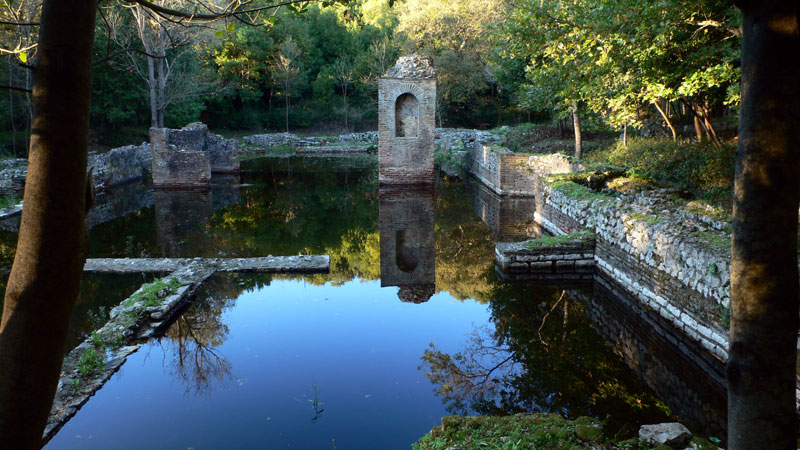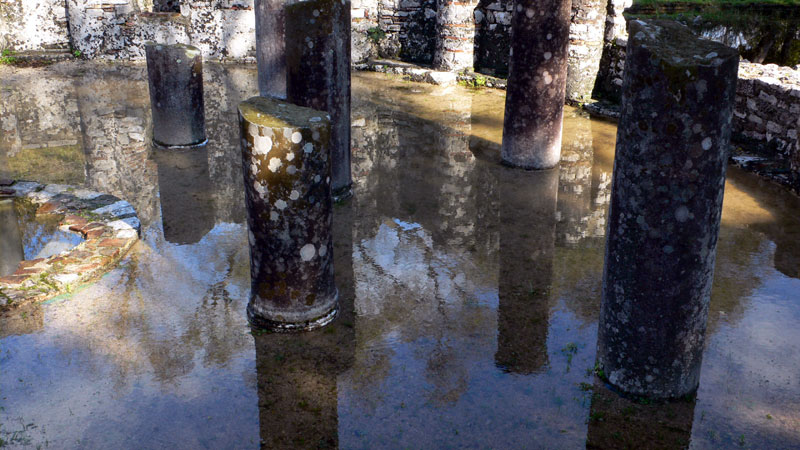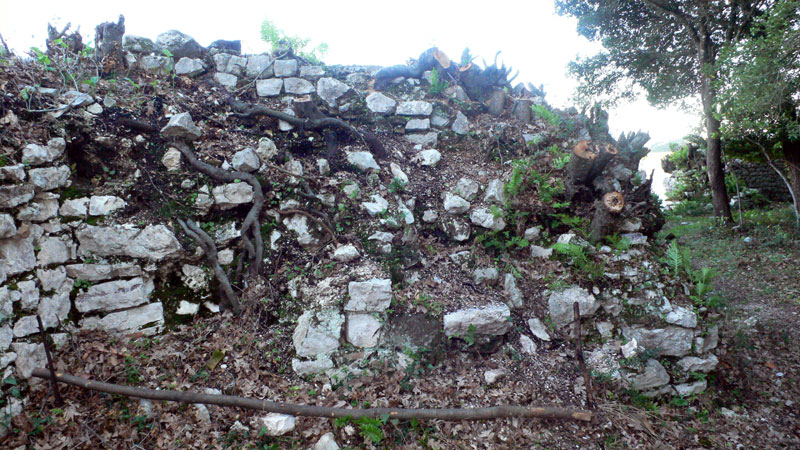


Butrint is a complex site by almost any frame of reference. Archeologically, historically and architecturally complex, the standing remains of the city are also subject and have been subject through time to a complex interplay of destructive factors. Therefore a definitive statement of 'condition' is difficult. We are talking about ruins and decaying masonry buildings, remnants of buildings and walls which are obviously far removed from the condition their patrons, designers and constructors had in mind, existing at present in a dynamic environment, which, for many buildings, differs radically from the one they were originally constructed in. Many have been excavated to below the present day water table which varies throughout the year and where once they were floored with mosaic of varying quality from poor to sublime, these floors now languish beneath pools of water in which a variety of species of plant, animal and insect flourish.
Three main factors affect and have affected the condition of the remaining standing monuments within the city of Butrint, these are Time, Water and Vegetation. If this survey is to be of any greater use than simply being an observance of a particular moment in time and for the survey to be of any benefit to the future understanding, management and conservation of Butrint, then these factors must be understood.
Time, and the passage of millenia of history, as a decaying factor affecting condition is obvious. It is the most dominant factor behind the condition we find the city of Butrint in today. History both human and natural is the defining factor. From the cataclysmic events which destroyed the Forum in the 3rd century, subsequent resettlement and rebuilding, wars and batterings to simple neglect time has reduced the once intact buildings erected at various times during the last two and a half millenia to the ruins we now see. Almost all the damage we see is historical. However, many of the buildings now exposed were buried until the early part of the last century when they were excavated by Ugolini. Burial preserves and excavation restarts the process of decay caused by weather and vegetation and other forces. So in some ways it can be seen that these ruins have been kept in a suspended state and that their exposure to the atmosphere has restarted their natural cycle of decay.
All the factors of decay, as we shall see, are linked, but the second most important is water. Water as fluctuating water table, water as rainfall, water as nutrient carrier for vegetation, water as salt solution and water as habitat are among some of the ways in which water affects masonry and buildings. Geophysical events caused the lowering of the ground level from the 3rd century AD and many buildings which were erected then and have since been excavated are now either seasonally or continually partially below the present water level
 .
.
This water level fluctuates according to rainfall and tide and creates a margin in walls which experiences a cycle of wetting and drying. If the water is in any way saline then this margin is subject both to the cycles of wetting and drying and also to cycles of salt deposition and crystallization. The groundwater provides for a luxurious environment for vigorous plant growth and a habitat for terrapins and mosquitos amongst a wide variety of other species. Rain falls heavily on walltops long since de-roofed and contributes to the weakening and destabilisation of walls. A hydrological study of Butrint has been commissioned by the Butrint Foundation. Grandiose plans for concrete ditches and constantly running pumps to drain Butrint have been mooted in the past but in reality the magnitude and potentially destructive nature of these schemes places them firmly in a past era. The water also creates atmospheric reflective surfaces in which to contemplate the beauty of the monuments, surrounding trees and sky above and the biodiversity it allows should not be regarded as problematic. The problems caused by the water can be managed, specifically by backfilling, which is sufficient as a permanent solution except in those areas where the exposure of a mosaic on a seasonal basis is desirable, such as in the Baptistery. Proposals are in hand for the presentation of mosaic in areas that are subject to the fluctuations of water level. (For high water mark in the baptistery, see photo above)
As will be further examined in the section of the report on Vegetation Management the luxurious growth within Butrint of a wide variety of plant species is probably, in the present, the most destructive vector contributing to the decay of the remaining fabric of Butrint city. Obviously without the abundant water vegetation would not be so great a problem. Plants grow everywhere a niche can be found. A combination of historic destructive forces have created sundered walls, cracks, shattered corework in massive masonry all of which are fertile areas for the opportunist growth of tree species, the growth of which further splits the existing cracks and when mature the tree roots can topple weakened walls.

Monuments are soon hidden by encroaching vegetation if left unmanaged. Excessive vegetation both has the capacity to both destroy masonry and to obscure masonry from inspection. The enchanted wood as a metaphor for Butrint is one which should be avoided, unless that enchanted wood is also well managed and kept away from the monuments.
The Condition Survey, then, is written with the above factors in mind.
The vegetation management proposals take as their priority the need to expose all maasonry that is at present overgrown and hidden in order to assess condition, record and consolidate as funds allow.
Also in mind is Cesare Brandi's definition of ruins:
'It would be a mistake to think that the reality of a ruin will lead us to the rules of it's conservation. With a ruin one does not merely define an empirical reality one also makes a value judgement about what has been simultaeneously considered under the headings of history and conservation. That is, one does not simply focus on it's current condition, but on it's past, which informs it's current presence (of little or no value in itself) and on the future, for which it should be preserved as a vestige or evidence of human activity and aas a departure point for conservation treatment. It cannot be called a ruin if it does not bear witness to human time- a ruin therefore, is anything that bears witness to human history but has changed so much from it's former existence as to be almost unrecognizeable.
When dealing with ruins restoration can only be a consolidation and preservation of the status quo.' (Cesare Brandi: 'Theory of Restoration')